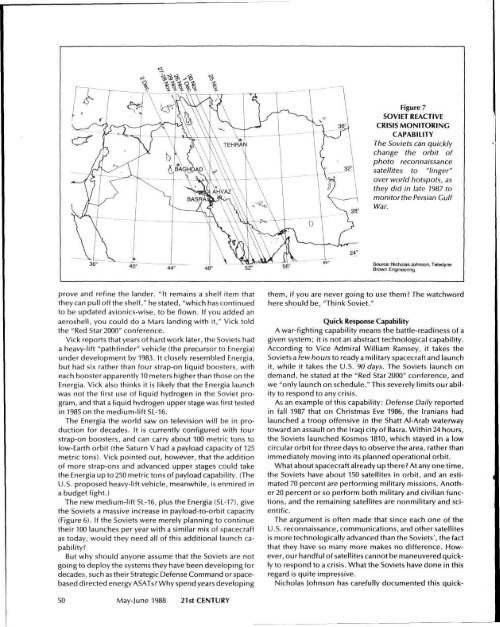The Geometry The Nucleus
The Geometry The Nucleus
The Geometry The Nucleus
You also want an ePaper? Increase the reach of your titles
YUMPU automatically turns print PDFs into web optimized ePapers that Google loves.
Figure 7<br />
SOVIET REACTIVE<br />
CRISIS MONITORING<br />
CAPABILITY<br />
<strong>The</strong> Soviets can quickly<br />
change the orbit of<br />
photo reconnaissance<br />
satellites to "linger"<br />
over world hotspots, as<br />
they did in late 1987 to<br />
monitor the Persian Gulf<br />
War.<br />
Source: Nicholas Johnson, Teledyne<br />
Brown Engineering.<br />
prove and refine the lander. "It remains a shelf item that<br />
they can pull off the shelf," he stated, "which has continued<br />
to be updated avionics-wise, to be flown. If you added an<br />
aeroshell, you could do a Mars landing with it," Vick told<br />
the "Red Star 2000" conference.<br />
Vick reports that years of hard work later, the Soviets had<br />
a heavy-lift "pathfinder" vehicle (the precursor to Energia)<br />
under development by 1983. It closely resembled Energia,<br />
but had six rather than four strap-on liquid boosters, with<br />
each booster apparently 10 meters higher than those on the<br />
Energia. Vick also thinks it is likely that the Energia launch<br />
was not the first use of liquid hydrogen in the Soviet program,<br />
and that a liquid hydrogen upper stage was first tested<br />
in 1985 on the medium-lift SL-16.<br />
<strong>The</strong> Energia the world saw on television will be in production<br />
for decades. It is currently configured with four<br />
strap-on boosters, and can carry about 100 metric tons to<br />
low-Earth orbit (the Saturn V had a payload capacity of 125<br />
metric tons). Vick pointed out, however, that the addition<br />
of more strap-ons and advanced upper stages could take<br />
the Energia up to 250 metric tons of payload capability. (<strong>The</strong><br />
U.S. proposed heavy-lift vehicle, meanwhile, is enmired in<br />
a budget fight.)<br />
<strong>The</strong> new medium-lift SL-16, plus the Energia (SL-17), give<br />
the Soviets a massive increase in payload-to-orbit capacity<br />
(Figure 6). If the Soviets were merely planning to continue<br />
their 100 launches per year with a similar mix of spacecraft<br />
as today, would they need all of this additional launch capability?<br />
But why should anyone assume that the Soviets are not<br />
going to deploy the systems they have been developing for<br />
decades, such as their Strategic Defense Command or spacebased<br />
directed energy ASATs? Why spend years developing<br />
them, if you are never going to use them? <strong>The</strong> watchword<br />
here should be, "Think Soviet."<br />
Quick Response Capability<br />
A war-fighting capability means the battle-readiness of a<br />
given system; it is not an abstract technological capability.<br />
According to Vice Admiral William Ramsey, it takes the<br />
Soviets a few hours to ready a military spacecraft and launch<br />
it, while it takes the U.S. 90 days. <strong>The</strong> Soviets launch on<br />
demand, he stated at the "Red Star 2000" conference, and<br />
we "only launch on schedule."This severely limits our ability<br />
to respond to any crisis.<br />
As an example of this capability: Defense Daily reported<br />
in fall 1987 that on Christmas Eve 1986, the Iranians had<br />
launched a troop offensive in the Shatt Al-Arab waterway<br />
toward an assault on the Iraqi city of Basra. Within 24 hours,<br />
the Soviets launched Kosmos 1810, which stayed in a low<br />
circular orbit for three days to observe the area, rather than<br />
immediately moving into its planned operational orbit.<br />
What about spacecraft already up there? At any one time,<br />
the Soviets have about 150 satellites in orbit, and an estimated<br />
70 percent are performing military missions. Another<br />
20 percent or so perform both military and civilian functions,<br />
and the remaining satellites are nonmilitary and scientific.<br />
<strong>The</strong> argument is often made that since each one of the<br />
U.S. reconnaissance, communications, and other satellites<br />
is more technologically advanced than the Soviets', the fact<br />
that they have so many more makes no difference. However,<br />
our handful of satellites cannot be maneuvered quickly<br />
to respond to a crisis. What the Soviets have done in this<br />
regard is quite impressive.<br />
Nicholas Johnson has carefully documented this quick-<br />
50 May-June 1988 21st CENTURY

















